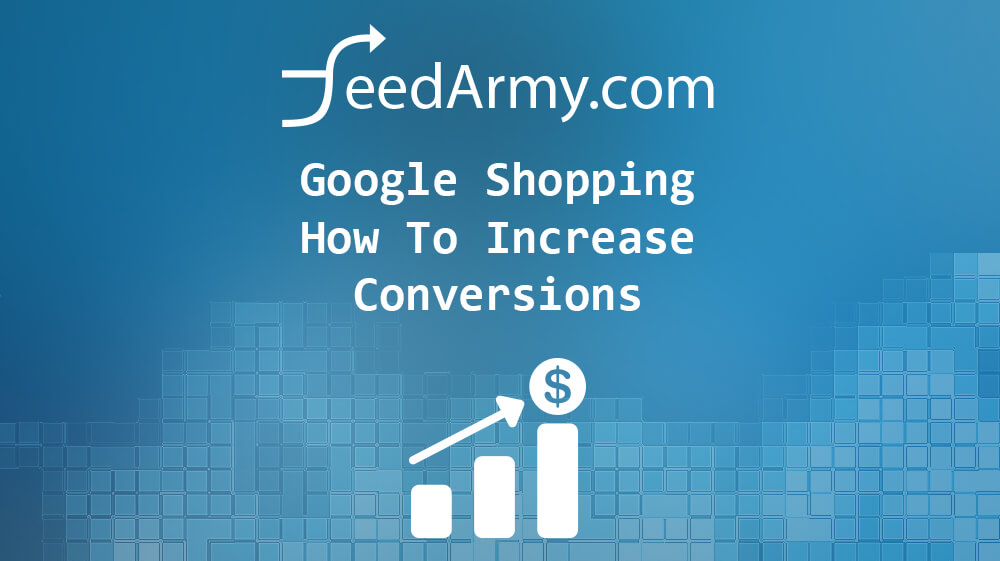When it comes to Google Shopping there are a lot of elements that play a big part in your advertising efforts. There is no simply trick, Google Shopping requires a high standard maintenance in different areas. In this article I will cover the different elements that contribute to the successes of your advertising efforts.
Data Feed
The data feed is the root of your advertising. It’s as simple as a tree, if the roots are not strong enough than the tree will fall. In Google Shopping the data feed defines the quality of your ads and overall ranking. Below is a list of key elements that I recommend you to focus on.
1) Provide Google Merchant with daily data feed updates
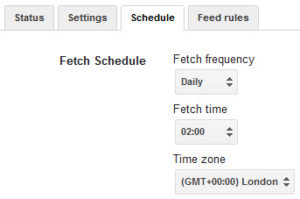
Google Shopping is very dynamic, the landscape changes constantly. Ensuring that your pricing and availability is updated every day enables you to have better advertising. For example if a product is out of stock, Google will not show your products and thus focuses your budget to products that are in stock.
2) Check on a regular basis that you do not have any errors or warnings (Google Merchant)
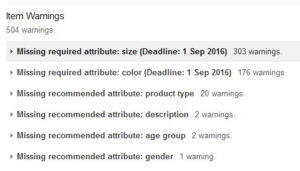
You can login to Google Merchant and click on your data feed to see any Warnings & Errors.
When you see errors, these need to be fixed to enable the product to be listed in Google Shopping. With warnings these are mostly recommendations to increase your data feed quality and ensuring you are visible within filtered results. For example if you see a warning that you have not added a color than your products will not be listed in filtered results. After your initial search term in Google Shopping or Image Search the customer has the ability to filter down in sizes, colors etc, this allows them to narrow down there requirements. If you do not add these values in the data feed than your products will not be listed within the filtered searches.
Resolving all Google Merchant data feed errors and warnings is very important alongside adding recommended attributes.
3) Improve your title quality
Improving your titles is one of the biggest ranking contributor. Having poor titles that are not optimized will result in poor search terms. Make sure your titles describe the product correctly to avoid any irrelevant clicks. A good practice is to stay between 60 to 80 characters. Using Google’s Keyword Planner is a good way to find out which keywords have the highest impressions.
4) High quality images
When listing your products, it is good practice to show the product in high quality. Meaning to avoid to much which space, adding text, other products, people, objects that are not part of the product etc… When you look for a product, a customer wants to see the product, not products with accessories, logos, watermarks etc… Also all the items mentioned are a policy violation
Ensure your images are at least 800 by 800 pixels.
5) Add the most top-level and accurate category
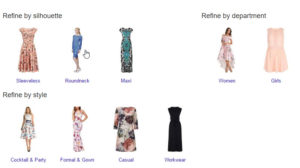
The more specific your category is, the better Google can categorize you when your products are shown. Along side the normal filter system, Google also shows top-level categories in search results. This to assist the customer in finding what they are looking for. The logic is very simple and is most noticeable when a search term is very broad. In this case Google tries to guide the customer in finding a more relevant result by listing more specific categories. If you do not specify where your product belongs, than the likely hood of your products been listed in these categories is much lower to none.
6) Variant Attributes (for parent & variant products)
Whether you are listing variants or main products, it is recommended to list attributes such as color, size, age group, gender, material or pattern. These attribute help your products to be listed in filtered sections. These filtered section appear on the left hand side when a customer searches for a generic search term. When adding these attributes you will be able to gain more impressions and thus lead into more sales.

7) Add a promotions data feed
By adding a promotions data feed, you will gain a competitive or equal edge. Customers love promotions and adding yours will increase your CTR (click-through rate). This is especially important if your competitors are already promoting.
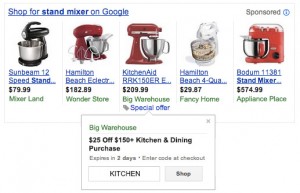
8) Automated Promotions
Additional promotions can be added via automated promotions data, although these are not controlled by you, you can add the data necessary to be eligible for these types of listings.
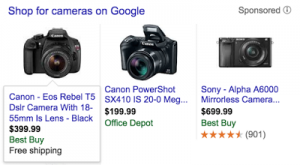
9) Equity
Beginner merchants tend to only publish the main products, while ignoring the listing of variants. Including variants will allow you to gain more equity meaning that the chances of a click is much higher. On Google Shopping you will have 20 products per page (excluding grouped products). Having the ability to show 12 products vs 1 product enables you to gain an upper hand compared to your competitors.
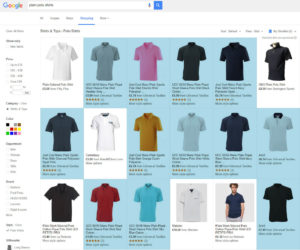
Landing Page
When having a high CTR, you would expect a certain amount of sales. However the landing page and the checkout define the end results. A high quality experience is required, even the smallest detail contributes towards the overall expectations..
1) Pricing
Even thought a customer clicks on your ad, it does not mean they have looked at your pricing on Google Shopping. They might first see your price on your landing page. Thus possibly creating a bounce. Ensure that you are competitively priced is key. From the huge list of clients I maintain, being the cheapest is not always key to success. I have clients that are high and low-priced both scenarios selling extremely well. The successes involve a lot of hard work in all 3 areas (Data Feed, Website & AdWords).
2) Incentives
Offering an incentive might convince a customer enough to stay on your website. Such as free delivery, x amount of discount, a free gift, etc…
3) Delivery Charges
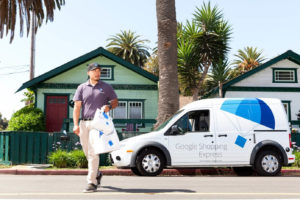
Depending on the niche of business, the delivery charges are a big contributor towards conversions. If you can provide Free Shipping, than showing that you do in a clear way will contribute in a positive way. If providing free delivery is not financially feasible than finding alternative ways to provide a benefit to your customers is a bonus. For example Free Delivery over x amount spend. Showing this information clearly on the landing page provides the customer with a clear indication what the costs are going to be. Allot of customers do like to know what the total price is going to be before they click on add to basket.
4) Titles
A great advantage is that you can have slightly different titles in Google Shopping versus the website, however they still need to perfectly describe the product correctly. Having incorrect titles can result in the customer clicking away from your website. Misrepresenting the product can result in a Google policy violation.
The landing page is key to your successes. The quality of your landing page contributes towards your conversions. Let’s say you have a CTR of 3% which is pretty good, but not a single person buys and you have at least 200 clicks. Than the low conversion rate is a strong signal that the customer is not liking something on the landing page. Doing some A B testing to find out what is going wrong is a good start.
5) Responsive Design
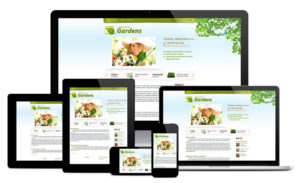
Being mobile, tablet, laptop and desktop friendly is extremely important. Especially now as the initial research is mostly done via mobile devices while payments are made via laptop or desktops. Having an easy to use landing page is ever more important.
6) Availability
With the digital age, shopping online is extremely lucrative. The expectations of customers is also very high, it is ever more important to ensure your products are available for delivery. Not updating your availability results in poor customer experience. And might affect other products. Customers with a grudge have good memory and might cause low CTR down the line.
[focus]
An experience to share :
I remember I was looking for a product online and noticed that a particular company had a lot of products out of stock. Every new search I did, I simply ignored this company.
[/focus]
7) Trust
With the ever expanding landscape of new shops popping up like Bangkok street food vendors, it is key to show that you are trustworthy. Listing your address, phone numbers, showing certificates, reviews, website design, server up-time, etc… all benefit the trust factor. Taking my own opinion into consideration, I would never buy from a site that has a poor design. A modern website for me is required.
[focus]
Some good tips:
- Display trust marks, such as seals and certificates
- Professional and well designed website
- Site contains well known brands
- Quick loading and easy navigation
- Display contact number and address
[/focus]
8) Popups
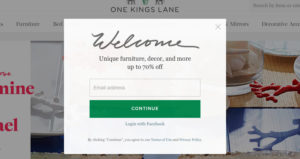
When you visit a website, how much do you like obstructive popups with discounts, social media likes, etc…? I don’t think there are many people who love these techniques. When you show a pop up, you are stopping the customer in it’s action. If you think these are effective and want to keep using them. Than I suggest you create goals with Google Analytics. Place a goal on the close button and one on the subscribe button. Than see how the results are. If the majority of customers close your message, than simply remove it.
[focus]
Tip :
Remove all newsletter popups, as this is considered Email harvesting which is against Google’s policy.
[/focus]
9) Reviews
Showing relevant reviews on the product landing page will show customer how valued your products are. This also contribute towards the trust value. I have already written two great articles on how to set up seller reviews and product reviews.
[focus]
Tip :
Do not submit false reviews or only show top 5 star reviews. You will be surprised how good authentic reviews will help your business.
[/focus]
If you want to know more I have written a great article on how to optimize your landing page.
Google Ads
With Adwords we need to start from the beginning. Ensure you have setup an effective campaign. Once you have created an effective campaign the below tips will definitely help you establish a superior setup.
1) Exclude Products
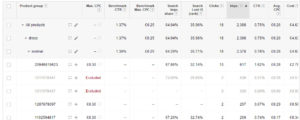
Excluding poor performing products, allows you to focus on products that do work. Reasons for poor product placements might be pricing, images, titles, relevance, landing page, etc… Removing these until your advertising efforts are 100% is key to success. You can always go back to these products and try to improve the quality.
2) Negative Keywords
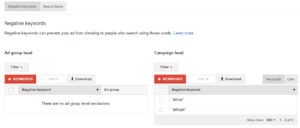
Adding negative keywords helps you remove the clutter and lets you focus on search terms that work. Certain keywords might bring you a lot of traffic, but if you have no sales, what is the point? Make sure that you also track phone calls and email contacts. Not because you have low or no conversion tracking, means that these search terms don’t work. Setting up tracking code on your emails and setting up phone tracking will assist you in understanding what works at a much higher level.
[focus]
For example:
- I would removing search terms that have 50 or 100 clicks and a very low CTR.
- I would also remove high impression keywords with no sales.
- Search terms with high clicks and high cost per conversion or ROAS
[/focus]
3) Bidding
When bidding on products, we want to bid on individual items and not on a group of products. This allows you to bid higher on top performing products while reducing the bidding on low performing products.
4) Scheduling
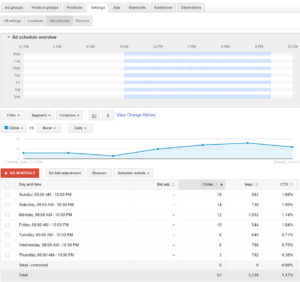
Scheduling is very important when it comes to advertising. You can activate your ads all day long and spend a lot of your budget on hours that do not convert. I recommend doing some A B testing and check if limiting the hours will save you budget while keeping the same conversion rate. And visa versa, if you are limiting your hours or days, try broadening your visibility to other hours and or days.
5) Ad Groups / Campaigns
Split up your products in to smaller ad groups by categories and or brands. It does not help to list all your products in one ad group or campaign. For example if you sell multiple brands in one category, than it makes sense to create an ad group for each brand. This allows you to see which search term performs better for which brand.
Another trick when you sell brand aware products is to set up two campaigns with the same ad group. Create one campaign with the brand name as a negative keyword, so that it only triggers generic search terms, than create a second campaign so all the branded search terms end up in there. This allows you to bid higher on branded search terms vs generic ones.
6) Enhanced CPC

Enable enhanced CPC within the campaign settings. This allows Google to use your conversion data and bid up to 30% higher on search terms / time / day where conversions are most likely.
7) Delivery Method

When you reach your daily budget limit a couple of time per week and you are unable to increase the budget, than change the Delivery Method in the campaign settings to Standard. This allows you to spread the budget evenly throughout the day.
8) Audiences (remarketing)
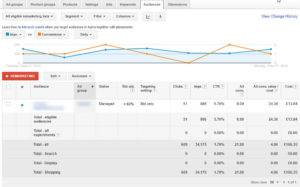
Enabling audience remarketing allows you to re target with a bid adjustment to customers who have not yet converted. Allowing you to get a second chance in showing your ads to the same customer. For example if I search for a Nike Shoe and land on your site, but for some reason I decided to continue using Google Shopping to find alternative Nike Shoes. Than with the remarketing enabled you can re target the same customer with a higher bid. This will work as long as the customer is searching for a product that you are eligible to be listed for.
9) Display Remarketing
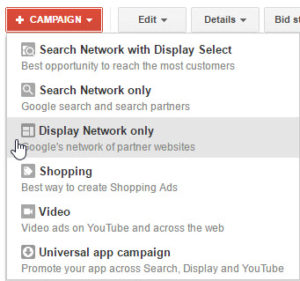
Similar to audience remarketing, instead of targeting the same customer on Google Shopping and Google Search, you are targeting them on 3rd party websites. This allows you to follow them around and display your Shopping products in front of them. I have written a great article explaining more on how to set up display remarketing.
10) Cost per conversion vs ROAS
I tend to stay away from cost per conversion as it does not reflect the actual sale value. A conversion can be a cheap accessory, an expensive product or even multiple products. You might have one product that is relatively cheap that is great at up selling or cross selling. This value can not be considered when you look at cost per conversion. While ROAS which is conversion value divided by advertising cost is very accurate in showing you how much profit you are gaining. This allows you to bid higher on products that you otherwise would not.
Other
1) Seasons
Listing products in the wrong season can lead to a miss match, resulting in low conversion.
2) Tripwire Offers
These types of offers are intended to sell an introduction product or a cheaper version, which if done correctly can lead to up sales or added accessory sales.
[focus]
Explanation :
The tripwire offer is a low-cost, painless offer that is easy for your prospect to buy into. So instead of asking someone to buy, for example, an expensive smart phone of $800, you would first offer them a cheaper alternative and list optional accessories and or up sell to a better model.
[/focus]
3) Lifetime Value
When selling products online in combination with up selling and cross selling, also consider the lifetime value of your customer. The advertising costs you spent on a particular sale can be used for future re marketing, brand awareness, email marketing etc…

